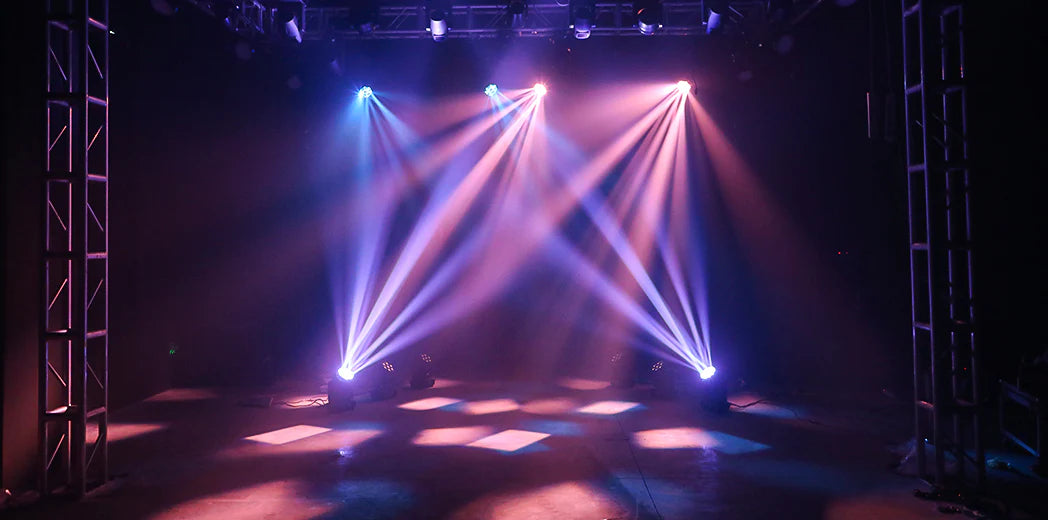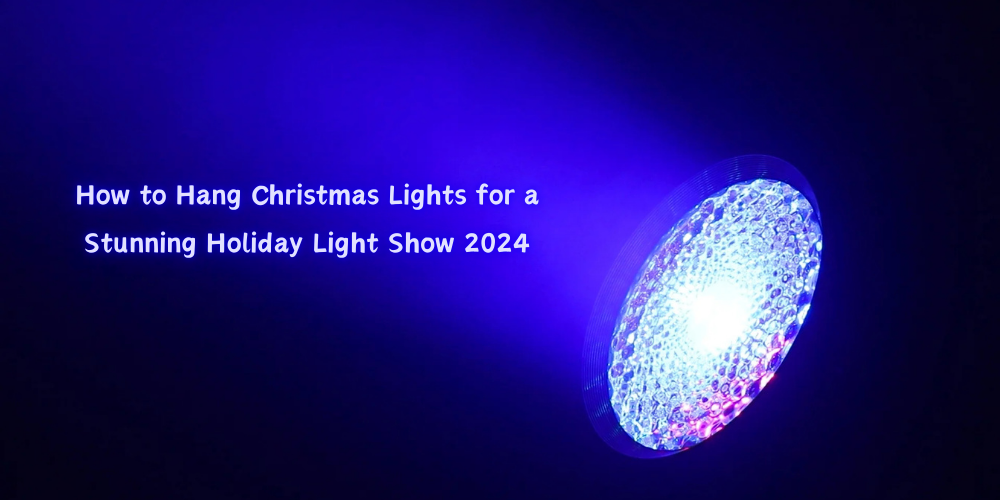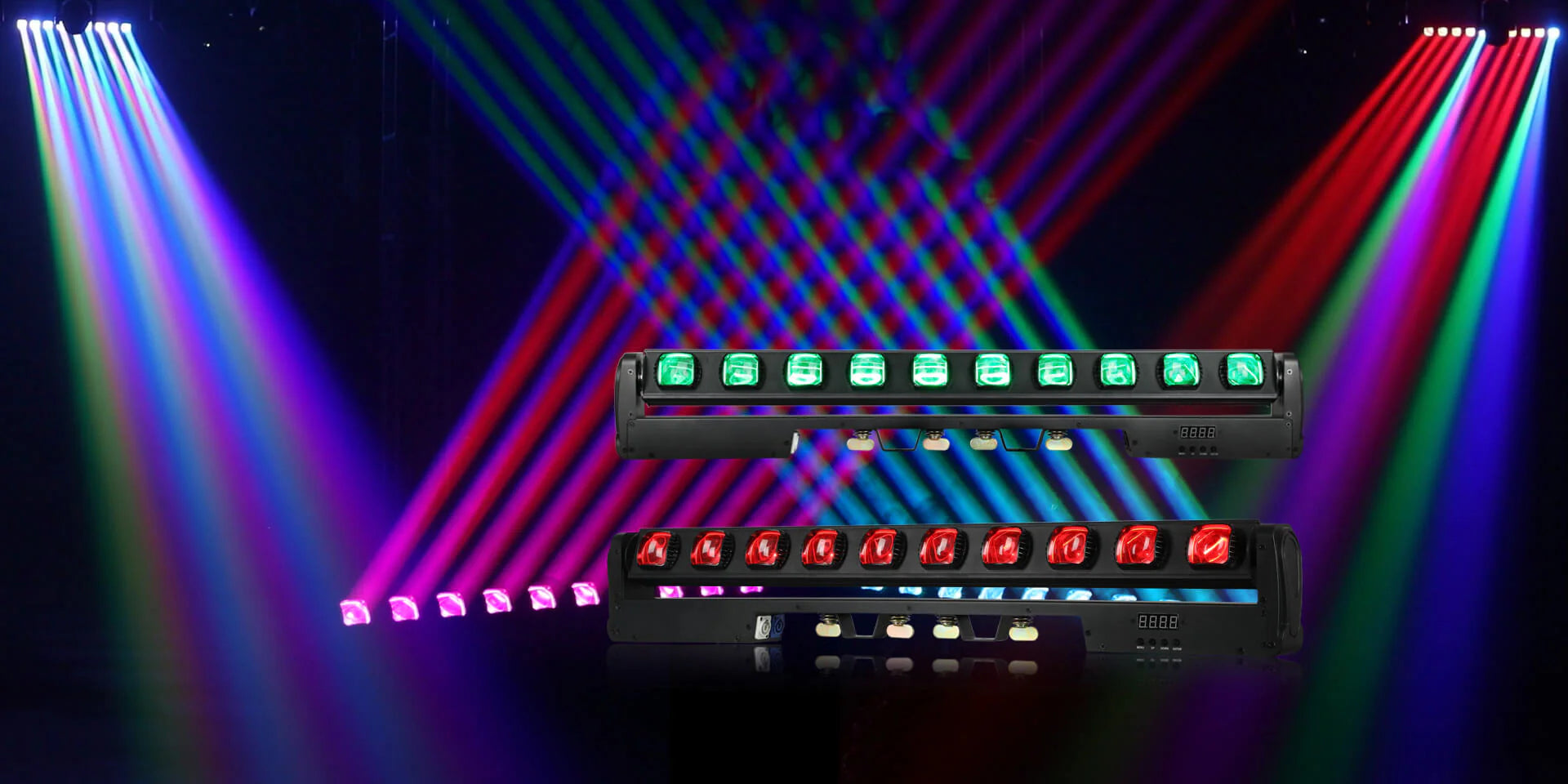L'illuminazione è uno degli elementi più essenziali nella produzione teatrale.
Dall'illuminazione degli artisti alla creazione dell'atmosfera, il giusto progetto di illuminazione può portare l'esperienza narrativa a nuovi livelli.
In questo articolo esploreremo i principali tipi di luci teatrali, i loro ruoli e come migliorano illuminazione del palcoscenico.
Il ruolo dell'illuminazione nel teatro
L'illuminazione in teatro è uno strumento trasformativo che fa molto più che illuminare il palco.
In sostanza, l'illuminazione garantisce che il pubblico possa vedere chiaramente gli artisti e gli elementi del palco, ma il suo impatto è molto più profondo.
Un progetto di illuminazione ben progettato crea atmosfera e atmosfera, trasformando momenti ordinari in esperienze coinvolgenti.
Utilizzando colori, intensità e motivi, i lighting designer evocano emozioni e danno il tono a ogni scena, guidando il pubblico senza soluzione di continuità attraverso la storia.
Inoltre, l'illuminazione gioca un ruolo fondamentale nel dirigere l'attenzione. L'uso strategico della luce mette in risalto personaggi o azioni chiave, indirizzando delicatamente l'attenzione del pubblico dove è più necessaria.
Aggiunge inoltre profondità e dimensione alla scenografia, creando livelli che danno vita alla narrazione. Che si tratti di una transizione fluida tra le scene o di un rafforzamento dei temi della produzione, l'illuminazione è un elemento fondamentale della narrazione teatrale.
Questi ruoli sottolineano perché la scelta delle giuste tipologie di luci è fondamentale per qualsiasi produzione.
Per saperne di più: Quali sono i diversi tipi di luci da palcoscenico?
Luci di scena del teatro
Riflettori sono probabilmente il tipo di illuminazione teatrale più iconico.
Concentrano un fascio luminoso e luminoso su un artista o su un'area specifica del palco, rendendoli indispensabili per dirigere l'attenzione del pubblico.
Faretti riflettori ellissoidali (ERS)

Faretti riflettori ellissoidali (ERS), noti anche come luci di profilo, sono un elemento fondamentale dell'illuminazione scenica e teatrale.
Rinomate per la loro messa a fuoco nitida e i bordi netti del fascio, queste luci utilizzano un riflettore ellissoidale per dirigere la luce con precisione.
Gli apparecchi ERS sono ideali per mettere in risalto aree specifiche o creare motivi utilizzando i gobo, grazie ai loro otturatori regolabili e ai tubi delle lenti.
La loro capacità di proiettare la luce con precisione li rende indispensabili per mettere in risalto gli attori, definire le scene o valorizzare le scenografie con effetti drammatici.
Segui i punti

I follow spot sono luci da palcoscenico specializzate, progettate per seguire e mettere in risalto gli artisti in tempo reale.
Azionati manualmente, producono un fascio luminoso e concentrato, con intensità, colore e dimensioni regolabili, il che li rende ideali per mettere in risalto momenti chiave o persone sul palco.
Comunemente utilizzati in teatri, concerti ed eventi, i faretti seguipersona garantiscono un'illuminazione dinamica e flessibile che si adatta perfettamente all'azione, aggiungendo un tocco coinvolgente e professionale a qualsiasi performance.
Benefici: I riflettori mettono in risalto i momenti chiave, i personaggi e i momenti salienti, rendendoli parte integrante della narrazione.
Illuminazione generale di lavaggio
Le luci wash forniscono un'illuminazione ampia e uniforme su tutto il palco, assicurando che ogni angolo sia adeguatamente illuminato e mantenendo al contempo un impatto visivo coerente.
Queste luci sono fondamentali per definire il tono di una scena, creando una tela su cui possono svilupparsi altri elementi di illuminazione.
Grazie all'illuminazione uniforme, le luci wash contribuiscono a eliminare le ombre dure, rendendole indispensabili per migliorare la visibilità e l'atmosfera in diverse performance.
Luci Fresnel

Le luci di Fresnel, che prendono il nome dal fisico francese Augustin-Jean Fresnel, sono un tipo di riflettore ampiamente utilizzato in teatro, al cinema e in televisione.
Sono caratterizzati da un design distintivo delle lenti a gradini che aiuta a focalizzare e ammorbidire la luce, producendo un fascio luminoso delicato e uniforme.
Note per la loro versatilità, le luci Fresnel consentono un controllo preciso dell'ampiezza del fascio luminoso, rendendole ideali per creare sia ampie zone di luce sia aree di messa a fuoco ristrette.
La loro intensità regolabile e la capacità di integrarsi perfettamente con altre luci li rendono un elemento fondamentale per scenografi e designer che cercano un'illuminazione professionale e dinamica.
Lattine PAR

Lattine PAR, abbreviazione di luci Parabolic Aluminized Reflector, queste luci emettono fasci intensi e sfocati, ideali per creare effetti spettacolari o creare l'atmosfera.
I PAR sono convenienti e ampiamente utilizzati sia nei teatri che nei concerti.
Questi apparecchi producono un fascio di luce intenso e ovale, il che li rende ideali per creare intense pennellate di colore o accenti drammatici.
Disponibili in varie dimensioni e con diverse intensità di fascio, i PAR Can vengono spesso utilizzati per illuminare grandi aree o creare atmosfere specifiche sul palco.
Il loro design robusto e la loro adattabilità li rendono i preferiti sia per le produzioni teatrali che per gli eventi dal vivo.
Pannelli LED e luci wash
Questi apparecchi moderni sono efficienti dal punto di vista energetico e in grado di produrre un'ampia gamma di colori. Sono ideali per creare cambi di atmosfera e illuminare ampie superfici.
I pannelli LED forniscono un'illuminazione uniforme e diffusa, ideale per fondali o per l'illuminazione generale del palcoscenico.
Grazie alla temperatura del colore regolabile e alle opzioni di oscuramento, queste luci offrono un controllo preciso, rendendole indispensabili per creare scene dinamiche e coinvolgenti nelle produzioni moderne.
Benefici: L'illuminazione wash garantisce un'illuminazione uniforme, consentendo al contempo flessibilità nell'impostazione del tono emotivo della scena.
Luci direzionali per il teatro
Le luci direzionali sono fondamentali per definire le dinamiche visive di un palcoscenico, offrendo precisione e messa a fuoco che valorizzano il design complessivo.
Queste luci creano profondità e scolpiscono gli artisti, le scenografie e gli oggetti di scena, conferendo alla produzione una ricca qualità tridimensionale.
Controllando attentamente angoli e intensità, l'illuminazione direzionale attira l'attenzione su aree specifiche, bilanciando al contempo le ombre per produrre un aspetto raffinato e professionale.

Luci anteriori: Posizionate in modo da illuminare gli artisti dal punto di vista del pubblico, le luci frontali garantiscono una visibilità chiara e mettono in risalto le espressioni facciali.
Luci posteriori: Dirette da dietro, queste luci creano un senso di profondità e separazione tra gli artisti e lo sfondo. Aggiungono un tocco drammatico, soprattutto nelle scene con silhouette.
Luci laterali: Montate ai lati del palco, le luci laterali sono perfette per mettere in risalto i movimenti e i contorni del corpo, in particolare negli spettacoli di danza.
Benefici: Le luci direzionali scolpiscono il palco concentrando la luce dove serve, migliorando la tridimensionalità e creando un aspetto raffinato e professionale che cattura l'attenzione del pubblico senza soluzione di continuità.
Illuminazione decorativa e ambientale
L'illuminazione decorativa e ambientale arricchisce l'attrattiva visiva del palco e contribuisce a mantenere l'immersione del pubblico.
Proiettori

I proiettori sono essenziali nell'illuminazione teatrale perché riescono a fornire un'illuminazione ampia e uniforme su aree di grandi dimensioni.
Progettati per produrre una luce morbida e diffusa, sono ideali per illuminare fondali, scenografie o per creare effetti ambientali.
A differenza dei faretti, i proiettori non concentrano la luce su un'area specifica, il che li rende perfetti per illuminare il palcoscenico in modo generale o per creare lievi effetti d'atmosfera.
La loro semplicità ed efficacia li rendono una scelta affidabile nelle produzioni teatrali.
Strisce luminose (luci di bordo)
Le strisce luminose, note anche come luci di confine, sono apparecchi lunghi e multilampada utilizzati nell'illuminazione teatrale per creare sfumature di colore o luci uniformi e uniformi sul palco.
Spesso montati sopra o lungo i bordi del palco, sono ideali per illuminare ciclorami, fondali o per aggiungere profondità agli elementi scenici.
Grazie alla possibilità di mescolare i colori e coprire ampie aree, le strisce luminose rappresentano una scelta versatile ed economica per migliorare l'impatto visivo di una produzione.
Luci ambientali

Le luci ambientali nell'illuminazione teatrale forniscono un'illuminazione generale e discreta che definisce il tono e l'atmosfera di una scena.
A differenza delle luci focalizzate o direzionali, l'illuminazione ambientale crea una luce morbida e diffusa che riempie lo spazio, garantendo visibilità e mantenendo un ambiente naturale e immersivo.
Spesso utilizzate insieme ad altri tipi di illuminazione, le luci ambientali aiutano a creare atmosfera, tempo e luogo, arricchendo l'esperienza narrativa sul palco.
Luci dinamiche e in movimento
L'illuminazione dinamica aggiunge emozione e drammaticità alle produzioni teatrali incorporando movimento ed effetti speciali.
Luci a testa mobile
Figura:
I fari mobili sono dispositivi avanzati per l'illuminazione teatrale, noti per la loro versatilità e capacità dinamiche senza pari.
Dotate di movimento motorizzato sia in direzione panoramica (orizzontale) che in direzione di inclinazione (verticale), queste luci possono riposizionare i loro fasci luminosi senza soluzione di continuità durante una performance.
Funzionalità aggiuntive come gobo personalizzabili, ruote colore, zoom e oscuramento consentono un controllo preciso, rendendoli ideali per creare effetti spettacolari, mettere in risalto gli artisti o migliorare le transizioni.
La loro capacità di adattarsi e muoversi in modo fluido aggiunge profondità ed energia a qualsiasi produzione teatrale.
Luci a fascio
Figura:
I fari Beam sono apparecchi potenti progettati per produrre fasci di luce stretti e concentrati, perfetti per creare effetti spettacolari nell'illuminazione teatrale.
Noti per la loro resa nitida e definita, eccellono nel penetrare l'illuminazione ambientale per evidenziare elementi chiave o aggiungere un'energia visiva sorprendente.
Spesso utilizzate per effetti speciali o per l'illuminazione d'accento, le luci a fascio conferiscono intensità e precisione alle produzioni teatrali, diventando un elemento fondamentale per scenografie dinamiche e coinvolgenti.
Effetti e luci speciali per il teatro
Le luci speciali sono progettate per creare effetti visivi unici che valorizzano la narrazione.
- Luci stroboscopiche: I flash ad alta intensità creano effetti drammatici o al rallentatore, spesso utilizzati nelle scene ricche di azione.
- Proiettori Gobo: Questi proiettano motivi, immagini o texture sul palco, aggiungendo un livello creativo alla produzione.
- Macchine per la foschia e la nebbia: Pur non essendo luci di per sé, questi dispositivi migliorano gli effetti luminosi rendendo visibili i fasci luminosi, aggiungendo profondità e mistero alle scene.
Tecnologie emergenti nell'illuminazione teatrale
I progressi nella tecnologia dell'illuminazione continuano a trasformare la produzione teatrale.
- Sistemi di illuminazione intelligenti: Questi apparecchi programmabili consentono ai progettisti di automatizzare sequenze di illuminazione complesse, risparmiando tempo e aumentando la precisione.
- Luci laser: I fasci ad alta intensità creano effetti nitidi e sorprendenti, adatti a produzioni moderne e futuristiche.
Combinazione di luci teatrali per un design scenico efficace
Per creare un progetto di illuminazione coerente spesso è necessario combinare più tipi di luci.- Tipi di luce a strati: La combinazione di faretti, luci wash ed effetti consente di creare scene dinamiche e visivamente accattivanti.
- Collaborazione con gli scenografi: La sincronizzazione del design dell'illuminazione con i temi impostati garantisce che tutti gli elementi visivi funzionino in armonia.
Impatto di un design di illuminazione di qualità
Un'illuminazione efficace può influenzare notevolmente la percezione e il gradimento di uno spettacolo da parte del pubblico. Illuminazione adeguata:
- Migliora l'attrattiva visiva di scenografie e costumi.
- Rafforza la narrazione evidenziando emozioni e transizioni.
- Migliora la visibilità e riduce al minimo le distrazioni dovute alla scarsa illuminazione.
Un progetto di illuminazione ben eseguito favorisce un ambiente visivo coeso che stimola la narrazione e il coinvolgimento, indirizzando l'attenzione del pubblico e le sue reazioni emotive durante l'intera rappresentazione.
Conclusione
Illuminazione teatrale è una forma d'arte a sé stante, in cui ogni tipo di luce gioca un ruolo unico nel creare un'esperienza immersiva.
Dalla precisione dei riflettori alla versatilità delle luci mobili, ogni apparecchio contribuisce alla magia del palcoscenico.
Con la continua evoluzione della tecnologia, i progettisti dell'illuminazione hanno a disposizione più strumenti che mai per dare vita alle loro visioni creative.
Comprendendo e celebrando queste tipologie di illuminazione, possiamo apprezzare il ruolo fondamentale che svolgono nel mondo del teatro.
Domande frequenti
1. Qual è il tipo di luce teatrale più comunemente utilizzato? I faretti, in particolare i faretti riflettori ellissoidali (ERS), sono tra i più comunemente utilizzati per la loro precisione e versatilità.
2. In che modo le luci a LED possono essere utili alle produzioni teatrali? Le luci a LED sono efficienti dal punto di vista energetico, versatili e in grado di produrre un'ampia gamma di colori, il che le rende ideali per l'illuminazione teatrale moderna.
3. In che modo i proiettori gobo migliorano l'allestimento scenico? I proiettori gobo creano motivi, immagini o texture, aggiungendo un elemento creativo e tematico al palco.
4. È possibile combinare sistemi di illuminazione tradizionali e moderni? Sì, le luci tradizionali come i Fresnel e i moderni sistemi LED possono essere combinati per creare design diversificati e visivamente accattivanti.
5.Quale ruolo gioca la foschia nella progettazione dell'illuminazione? La foschia potenzia gli effetti di luce rendendo visibili i raggi, aggiungendo profondità e atmosfera al palco.






1 commento
Noah
In-depth information, that’s quite nice!
Lascia un commento
Nota che i commenti devono essere approvati prima di essere pubblicati.
Questo sito è protetto da hCaptcha e applica le Norme sulla privacy e i Termini di servizio di hCaptcha.